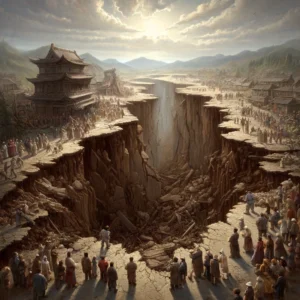1556 Shaanxi Earthquake
The 1556 Shaanxi earthquake stands as one of the deadliest earthquakes ever recorded in human history. Occurring on January 23, 1556, in the Huaxian region of Shaanxi province in China, it is estimated to have caused the deaths of approximately 830,000 people. This seismic event, also known as the Jiajing earthquake, left an indelible mark on Chinese history and offers critical lessons on earthquake preparedness and resilience. In this article, we explore the causes, impacts, and lessons learned from the 1556 Shaanxi earthquake.

Causes of the 1556 Shaanxi Earthquake
Tectonic Setting
The primary cause of the 1556 Shaanxi earthquake was the tectonic activity along the Weihe Basin, a region characterized by significant seismic activity due to the presence of multiple fault lines. The earthquake was a result of the movement along the Huashan Fault, a major fault line that runs through the Shaanxi province.
Geological Factors
The region’s geological composition also played a crucial role in the earthquake’s severity. The Loess Plateau, where the earthquake struck, is composed of highly compacted, fine-grained silt known as loess. This type of soil is particularly susceptible to seismic shaking, leading to massive landslides and ground collapses during the earthquake.

The Human and Environmental Impact
Massive Loss of Life
The 1556 Shaanxi earthquake is estimated to have caused approximately 830,000 deaths, making it the deadliest earthquake in recorded history. The high death toll was primarily due to the collapse of cave dwellings, which were a common type of housing in the region. These dwellings, carved into the loess cliffs, were extremely vulnerable to seismic activity.
Destruction of Infrastructure
The earthquake caused widespread destruction across the region. Entire towns and cities were reduced to rubble, and critical infrastructure such as bridges, roads, and water systems were destroyed. The collapse of buildings and infrastructure further complicated rescue and relief efforts, leading to more deaths in the aftermath.
Environmental Consequences
The earthquake triggered massive landslides and ground fissures, drastically altering the landscape of the region. Rivers were dammed by landslides, leading to flooding in some areas while other regions faced water shortages. The environmental changes caused by the earthquake had long-term impacts on agriculture and settlement patterns in the region.

Social and Economic Impact
The social and economic impact of the 1556 Shaanxi earthquake was profound. The loss of life and destruction of property plunged the region into chaos. Many families were left homeless and destitute, struggling to find food and shelter. The economic disruption caused by the earthquake affected trade and commerce, leading to shortages of goods and a rise in prices.
Cultural Impact
Historical Records and Literature
The 1556 Shaanxi earthquake has been extensively documented in Chinese historical records. Accounts of the earthquake can be found in various annals and chronicles from the Ming Dynasty, providing detailed descriptions of the event and its aftermath. These records have been invaluable for modern researchers studying the earthquake.
Changes in Architecture
In the wake of the earthquake, significant changes were made in construction practices and architectural designs in the region. The vulnerability of cave dwellings was recognized, and efforts were made to promote safer building techniques. The disaster also led to increased attention to earthquake-resistant construction, influencing building practices in China for centuries.
Lessons Learned from the 1556 Shaanxi Earthquake

Importance of Earthquake-Resistant Construction
One of the critical lessons from the 1556 Shaanxi earthquake is the importance of earthquake-resistant construction. The collapse of cave dwellings highlighted the need for safer housing designs that can withstand seismic activity. Modern earthquake engineering has its roots in these historical lessons, emphasizing the need for robust building codes and construction practices.
Need for Preparedness and Early Warning Systems
The devastation caused by the earthquake underscored the importance of disaster preparedness and early warning systems. While such systems were not available in the 16th century, the need for timely and accurate information to guide evacuation and relief efforts has been recognized. Today, earthquake-prone regions around the world invest in early warning systems to minimize the impact of seismic events.
Role of Community and Government Response
The response to the 1556 Shaanxi earthquake highlighted the crucial role of community and government in disaster recovery. The coordination of relief efforts, provision of aid, and reconstruction activities are essential for helping affected populations recover from such disasters. Modern disaster management strategies emphasize the importance of community involvement and government support in building resilience.
Advances in Seismology
The study of the 1556 Shaanxi earthquake has contributed to advances in the field of seismology. Historical records of the earthquake have provided valuable data for understanding seismic activity in the region. This has informed the development of seismic hazard maps and risk assessments, helping to improve earthquake preparedness and mitigation strategies.
Modern Reflections and Earthquake Preparedness
Improving Building Codes
Modern building codes have been significantly influenced by historical earthquakes like the 1556 Shaanxi earthquake. Today, seismic design principles are integral to construction practices in earthquake-prone areas. Building codes are continually updated to incorporate the latest research and technological advancements in earthquake engineering.
Public Awareness and Education
Public awareness and education are critical components of earthquake preparedness. Educating communities about the risks of earthquakes and the steps they can take to protect themselves is essential for minimizing casualties and damage. Earthquake drills, emergency kits, and awareness campaigns are vital tools in fostering a culture of preparedness.
Technological Innovations
Technological innovations have revolutionized earthquake preparedness and response. Early warning systems, advanced seismic monitoring networks, and resilient infrastructure design are some of the key developments that have emerged in recent years. These technologies enhance our ability to detect earthquakes, provide timely warnings, and reduce the impact of seismic events.
Conclusion
The 1556 Shaanxi earthquake remains a poignant reminder of the destructive power of earthquakes and the importance of preparedness and resilience. The lessons learned from this catastrophic event have shaped modern approaches to earthquake engineering, disaster management, and community preparedness. As we continue to advance our understanding of earthquakes and improve our response capabilities, we honor the memory of those who perished in the 1556 Shaanxi earthquake by striving to build a safer and more resilient future.
By reflecting on the past and embracing modern advancements, we can better protect our communities and reduce the devastating impact of future earthquakes. The legacy of the 1556 Shaanxi earthquake serves as a testament to the enduring human spirit and our capacity to learn, adapt, and persevere in the face of natural disasters.
Relevant Keyword Phrase: 1556 Shaanxi earthquake
Meta Descriptions:
- The 1556 Shaanxi Earthquake: A Catastrophic Event in Chinese History
Explore the causes, impact, and lessons from the 1556 Shaanxi earthquake, the deadliest earthquake in recorded history with approximately 830,000 deaths. - Understanding the 1556 Shaanxi Earthquake and Its Legacy
Learn about the 1556 Shaanxi earthquake, its devastating impact on China, and the significant advancements in earthquake preparedness that followed. - 1556 Shaanxi Earthquake: Causes, Impact, and Lessons Learned
Discover the historical significance of the 1556 Shaanxi earthquake, its impact on Chinese society, and the critical lessons for modern earthquake preparedness.
Tags:
- Earthquakes
- Disaster Preparedness
- Historical Events
